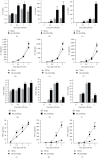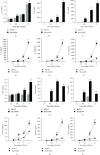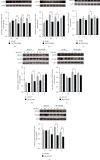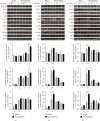sNASP Mutation Aggravates to the TLR4-Mediated Inflammation in SLE by TAK1 Pathway
- PMID: 37771504
- PMCID: PMC10533267
- DOI: 10.1155/2023/4877700
sNASP Mutation Aggravates to the TLR4-Mediated Inflammation in SLE by TAK1 Pathway
Abstract
Genetic factors play an important role in the pathogenesis of systemic lupus erythematosus (SLE), and abnormal Toll-like receptor (TLR) signaling pathways are closely related to the onset of SLE. In previous studies, we found that the mutant somatic nuclear autoantigenic sperm protein (sNASP) gene in the mouse lupus susceptibility locus Sle2 can promote the development of lupus model mice, but the mechanism is still unclear. Here, we stimulated mouse peritoneal macrophages with different concentrations of lipopolysaccharide. The results showed that sNASP gene mutations can promote the response of the TLR4-TAK1 signaling pathway but have no significant effect on the TLR4-TBK1 signaling pathway. sNASP mutations enhanced TLR4-mediated nuclear factor-κ-gene binding and mitogen-activated protein kinase activation and IL-6, tumor necrosis factor secretion in murine peritoneal macrophages. Collectively, our study revealed the impact of sNASP gene mutation on the sensitivity of TLR4 receptors in mouse peritoneal macrophages and shed light on potential mechanisms underlying inflammation in autoimmune diseases.
Copyright © 2023 Yatao Bao et al.
Conflict of interest statement
The authors declare that they have no competing interests.
Figures







Similar articles
-
Regulation of TLR4 signaling through the TRAF6/sNASP axis by reversible phosphorylation mediated by CK2 and PP4.Proc Natl Acad Sci U S A. 2021 Nov 23;118(47):e2107044118. doi: 10.1073/pnas.2107044118. Proc Natl Acad Sci U S A. 2021. PMID: 34789577 Free PMC article.
-
CYLD links the TRAF6/sNASP axis to TLR4 signaling in sepsis-induced acute lung injury.Cell Mol Life Sci. 2025 Mar 20;82(1):124. doi: 10.1007/s00018-025-05654-4. Cell Mol Life Sci. 2025. PMID: 40108019 Free PMC article.
-
A Variant of the Histone-Binding Protein sNASP Contributes to Mouse Lupus.Front Immunol. 2019 Apr 2;10:637. doi: 10.3389/fimmu.2019.00637. eCollection 2019. Front Immunol. 2019. PMID: 31001259 Free PMC article.
-
Association between Toll-Like Receptor 4 Polymorphisms and Systemic Lupus Erythematosus Susceptibility: A Meta-Analysis.Biomed Res Int. 2016;2016:7842587. doi: 10.1155/2016/7842587. Epub 2016 Aug 29. Biomed Res Int. 2016. PMID: 27652268 Free PMC article. Review.
-
Toll-Like Receptor 4 (TLR4)/Opioid Receptor Pathway Crosstalk and Impact on Opioid Analgesia, Immune Function, and Gastrointestinal Motility.Front Immunol. 2020 Jul 8;11:1455. doi: 10.3389/fimmu.2020.01455. eCollection 2020. Front Immunol. 2020. PMID: 32733481 Free PMC article. Review.
References
-
- Justiz Vaillant A. A., Goyal A., Varacallo M. Systemic Lupus Erythematosus . Treasure Island (FL): StatPearls; 2022. - PubMed
MeSH terms
Substances
LinkOut - more resources
Full Text Sources
Medical
Molecular Biology Databases
Miscellaneous

